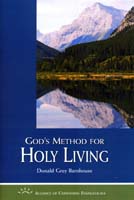
I remember seeing pictures of George VI at his coronation, with his enormous jeweled crown, his ermine robes, and all the pomp that marked the occasion. It was very impressive. But I saw another picture of George VI where I truly knew him as king. The photograph showed the East End of London after it had been bombed by the Nazis into a heap of rubble. George VI was there with Winston Churchill to inspect the damage. He wore no crown or ermine robe, just a suit and a derby hat. He looked totally unremarkable, except for one thing. As he walked through the debris, he cried. As he saw the damage, his suffering people, the Union Jacks his subjects had draped over the wreckage of their homes, he wept. Churchill’s memoirs record that as the people watched their king weeping in the midst of their ruin, they said again and again, “He loves us. He loves us.”

The gospel begins with historical facts, but these facts need explanation, for the facts by themselves do not constitute good news. Christ died; so did millions of other men. Christ was buried; so were millions of others. Christ rose from the dead; they have said that about other men, though it has only been true of Him. Paul says in 1 Corinthians 15:3–4, “For I delivered to you... what I also received, that Christ died for our sins in accordance with the scriptures, that He was buried, that He was raised on the third day in accordance with the scriptures.” The fact of the gospel has three parts to it: death, burial, and resurrection. But, these facts are not good news until you add the subsequent clauses. Christ died “for our sins”; then it becomes good news. Christ died “according to the scriptures”; thus it immediately becomes good news. The facts without the purposes behind them are meaningless; they are no more gospel than the story of the death of Socrates.

As we look at the Book of Mark, we need the Spirit of God to reveal to us the unique message He wants to bring us. Throughout their lives, God prepared each of the four gospel writers for the task of creating a particular portrait of Christ. The portrait of Christ we see in Mark was written by a menial servant. In Acts 12:25, it says that, “Barnabas and Saul [Paul] returned from Jerusalem ... bringing with them John whose other name was Mark.” In chapter 13 verse 5, it says that, “they had also John [with them] to minister” (KJV). This is the man who later wrote this gospel.

Why are there four gospels? Some have looked upon the Bible as a human book and said, “That’s simple: men named Matthew, Mark, Luke, and John each sat down and said, ‘I’m going to write a biography.”’ I cannot take any such opinion. The Holy Spirit determined before the foundation of the world that there would be these four portraits of the Lord Jesus Christ. He took four men and prepared them to tell the story of Jesus’ life, each in his own way. By that means He fulfilled His purpose: to present to us the Lord Jesus Christ in His various aspects.

The people of Israel had a terrible time in Egypt, for they were ill treated for many years. But at last God sent a deliverer, Moses, who led them out of Egypt and back to the land of promise. On the way they camped at the foot of rugged Mt. Sinai, and there God spoke to them, and gave them a new test, the test of law. Perhaps the people might think, “Well, if we had a set of commands to tell exactly what God wanted, we would not fail as we did under the other tests.” God gave them such a set of commands, the ten commandments, and a great many other rules about everything they might do. When God spoke to them they promised to do all that He said. But even before a month had passed they had broken all the commands. And down through the years they continued to fail in this test, though it lasted till the Lord Jesus died. God sent prophets to warn them, but still they continued to fail in the test of the law. At last they killed the Lord Jesus, and God judged the whole nation of Israel by letting their land be conquered, Jerusalem burned and all the people scattered.




















